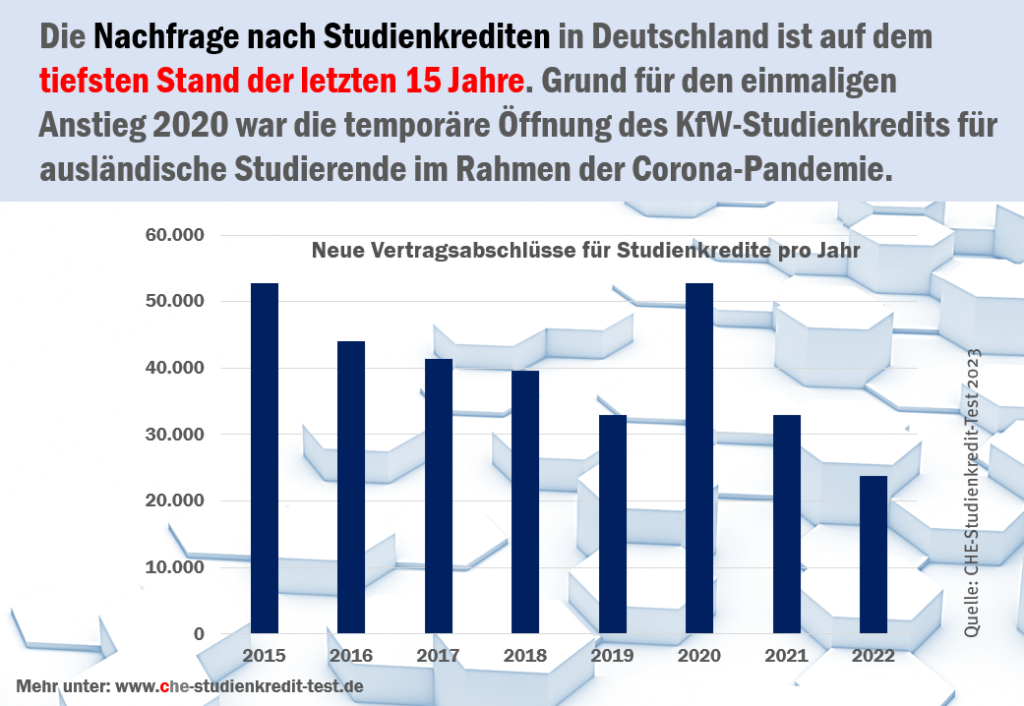 Foto: Bruno / Pixabay
Foto: Bruno / PixabayThe number of new student loans taken out in Germany fell to an all-time low of just 23,820 contracts in 2022. At the same time, the interest rate charged by the market leader hit a peak of around eight per cent. Ulrich Müller, expert on student funding at the CHE Centre for Higher Education, considers the market for student loans to be on the verge of becoming insignificant – with severe consequences for students. These are the findings of the annual evaluation conducted as part of the CHE Student Loan Test 2023.
The number of new student loans taken out in Germany has fallen to its lowest level in over 15 years. Last year, as few as 23,820 people signed a new contract for a student loan or education fund. This means that around 9,000 fewer contracts were taken out than in the previous year, representing a decline of 28 per cent.
The number of new student loan customers had already plummeted between 2014 and 2019. In 2020, the number of newly signed contracts shot up again to 52,000. This increase was due to the coronavirus emergency measures put in place by Germany’s Federal Government. The KfW Student Loan, which takes the largest market share, was provided interest-free for a limited period during the disbursement period and made available to foreign students for a short time. However, these measures only had a short-lived effect; the trend that had been apparent before this blip continued in 2021 and 2022.


“We are currently witnessing the collapse of the student loan market in Germany in slow motion,” remarked Ulrich Müller, summarising the trend. “When it comes to new customer numbers, both the Federal Office of Administration’s Education Loan and the KfW Student Loan have been declining dramatically over the past decade,” stated the expert on student funding at the CHE Centre for Higher Education.
The market leader – the KfW Student Loan – reported 15,500 new contracts in 2022, a third fewer than in the previous year. Ulrich Müller doubts that this trend will be reversed. “As of April 2023, the KfW Student Loan has an effective interest rate of almost eight per cent, making it by far the highest rate charged by any provider on the market. This is a dramatic development, given that student loans often used to be the last resort for students when all other financing options were either unavailable or no longer viable. What are cash-strapped students supposed to do now that the KfW offer, which desperately needs a revamp regardless, no longer represents a viable alternative because of its exorbitant interest rate? Unfortunately, I have not yet seen any signs of the Federal Government taking countermeasures by lowering the interest rate on KfW Student Loans, as it did once before in 2008,” commented the author of the CHE Student Loan Tests.
For the student financing market as a whole, Ulrich Müller has noticed an increasingly worrying trend. Not only has there been a decline in student loans and scholarships – the number of students taking advantage of the state BAföG student grant programme has dropped to around 11 per cent. “85 per cent of students in Germany finance their studies with the help of their parents or by working part-time, because they are either unable or unwilling to resort to the student funding options offered by the state,” emphasised Ulrich Müller. When current state services are incompatible with realistic education biographies or the conditions are utterly unacceptable, he continued, this also challenges equity of access to higher education and degree completion. Fundamental reform of the BAföG system is long overdue, he added. In future, the mechanism must offer not only low-interest or even interest-free loan facilities, but also the option of pre-financing tuition fees at private universities, which are in ever greater demand. In the past, students often took out a student loan or education fund for this option.
Around 63,000 students in Germany currently receive money from an education fund or a student loan. This is equivalent to 2.2 per cent of the student population. A total of more than €35 million is paid out to students each month, averaging €557 per capita. Around a quarter of a million people are currently in the repayment phase. In other words, they have finished university and are now in the process of paying off their debts.
Many of the 56 student loans and education funds assessed in this year’s CHE Student Loan Test 2023 once again gained top marks in several of the five assessment categories (access, volume, costs, risk mitigation and flexibility).
About the CHE Student Loan Test:
The CHE Student Loan Test 2023, developed in collaboration with Handelsblatt, was published this year for the eighteenth time. Using 21 individual criteria, it assesses the advantages and disadvantages of 56 student loans that are currently on offer. The test is based on information provided by the loan providers. The wide range of detailed information provided in the publication gives students and prospective students a transparent overview of the market. In addition, students can use tables to calculate their individual requirements. The CHE Student Loan Test is freely available at www.che-studienkredit-test.de.
CHE Studienkredit-Test 2023 20. June 2023 1.35 MB 14380 downloads
Müller, Ulrich: CHE-Studienkredit-Test 2023 - Studienkredite, Abschlussdarlehen...
Bildquelle: Pixabay
